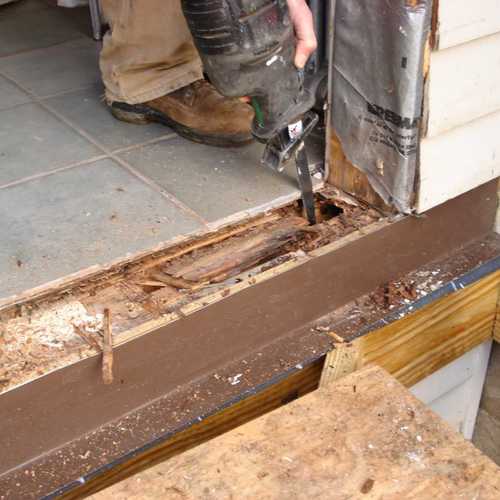Water Management: Drain Water, Don’t Trap It
Because all windows leak at some point, rough openings need to shed water. You can slope the sill with a piece of beveled siding or install a backdam as shown in the detail. On top of the sill, install a sill pan — either a peel-and-stick membrane or a preformed sill pan.
MORE VIDEOS IN THIS SERIES
3. Sill Pan with Regular Peel-and-Stick 4
. Sill Pan with Flexible Peel-and-Stick
5. Flashing Flanged Window Jambs
7. Head Flashing Windows/Doors
RELATED VIDEOS
 Air-Sealing Inspection of a Window
Air-Sealing Inspection of a Window
Video Transcript:
Creating a self-draining sill pan is the most important part of window installation. Right now, if I put down sill flashing tape on top of a flat rough opening, the problem I’m going to run into is that half of the time the water can drain to the inside and the other half it can drain to the outside.
Backdams are a simple way to keep water out
Now, I want to increase the likelihood that the water is going to drain to the outside of the wall. There are a couple of options that I can use to do that. The first and simplest is to use some scrap plywood or other wood to create a positive backdam, where the wood is built up along the back edge of the rough opening and the sill pan material is folded down to create a lip on the inside edge so the water can’t drain to the inside. Now, that runs into a couple of problems because you may end up with a rough opening that isn’t deep enough to accommodate the window itself plus this solid piece of material built up back there; you may end up with a height problem. An alternative to that is to use flexible or compressible types of backdam material; one of those is using a backer rod and the other is using a peel-and-stick insulating tape.
Sloped sills leave nothing to chance
Another way to create a simple draining sill pan is to slope the surface of the rough opening on the sill. That can be done by applying a piece of beveled cedar siding or beveled pine siding. One of the things you have to keep in mind if you’re going to use a clapboard system is you’re going to end up kicking up the rough opening sill height by about 3/8 in., so you need to make an adjustment for that. On the advantage side, it’s sloped, so that’s going to drain the water. Many of the other systems—either that piece of plywood strip or the foam backing strips—are only creating a backdam, and it’s not going to create a slope to the bottom of the sill, so water isn’t going to tend to run out; it’s just going to tend to puddle there. And that can be a concern if you have a wood-framed window: That wood might be sitting in a puddle of water over a period of time.
For places with wind-driven rain, use both
One thing you can do—and I’ve done in some cases—is actually install both. I’ve put down a piece of beveled cedar siding and then put a piece of foam to give me both the backdam protection and that sloped sill. So, there’s a whole bunch of different ways of approaching the whole system.
Weekly Newsletter
Get building science and energy efficiency advice, plus special offers, in your inbox.








10 Comments
Sill flashing
What about windows with an integral sloped sill? Is this practice still recommended? What about the gap at the front of the window that such sloping would create?
Yes, slope the sill plate
Most windows have a sloped sill to deflect rain water away. But that doesn't let you off the hook for sloping the sill plate -- when water leaks in from the top or sides, a sloped sill plate will channel it out. The flange will cover the gap at the front, stopping wind-blown rain, and a bead of canned foam as far towards the inside will seal the opening to air.
Waterproofing the window sills
I have always found that beveled cedar siding cut to sill size, caulked and covered with a butyl rubber tape has been very effective for the base or sill of a window installation. And the added bonus is the protection from moisture rot is inherent with cedar's natural oils.
Why wouldn't you slope the sill stud?
To get the sill to slope, why wouldn't you install the bottom stud of the rough opening at an angle, rather than trying to build it up with beveled wood later?
Response to Michael Bluejay
Michael,
Because cutting the studs at 90 degrees is faster and easier.
Adding a length of beveled clapboard to the rough sill is the easier way to go. But nothing is stopping you from using your suggested technique if you prefer it. Just make sure that your rough opening is properly sized for the window and required flashing.
Michael
There is no benefit to having the sill sloped except under the window. If you angle the whole sill framing, the interior and exterior faces are no longer in the same plane as the rest of the framing. You also have to angle cut the cripples underneath the sill. Once this is done the slope of the sill inside the window makes installing interior trim more difficult.
Instead of building up a slope you can use a table saw to bevel an appropriate amount of the sill framing. Either way works fine.
Hi Michael, can you explain what you mean by "Instead of building up a slope you can use a table saw to bevel an appropriate amount of the sill framing. Either way works fine."?
Thanks!
Slav,
Say the portion of your window frame that is inside the flange is 2" wide. Before framing the sill plate, if you run it though a table saw with the blade set at a 6 degree angle so only the last 2" on the sill gets cut, you end up with a slope where you need it, and the rest of the sill is flat.
Ah! Got it!
I like the idea of both. I am normally detailing very thick walls with plywood bucks and doing both is easy. I plan the inside of the buck to be the rough opening plus 1 1/2" in height for a 2x4 across the bottom. I'm often dealing with very deep metal pan sill flashing so the 2x helps with pitch. I'm normally dealing with flangeless windows as well.
Log in or create an account to post a comment.
Sign up Log in